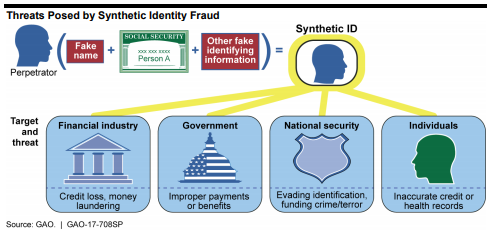With the start of the new year, you may have resolved to make a change in your life. Maybe you've even gone so far as to pledge to become a "new you." But someone may have already claimed that "new you," stealing your credentials and using them to create a new identity. Identity theft is a growing problem, resulting in millions of dollars in damage around the world. And now there is a modern twist to this old and costly problem: synthetic identity fraud. Panelists at a forum convened by the Government Accountability Office (GAO) define this problem as a "crime in which perpetrators combine real and/or fictitious information, such as Social Security numbers and names, to create identities with which they may defraud financial institutions, government agencies, or individuals." (Read forum highlights on the GAO website.) According to the U.S. Federal Trade Commission, synthetic identity fraud is the "fastest growing and hardest to detect" form of identity theft.
This graphic from the GAO illustrates how this type of identity fraud differs from what we have traditionally defined as identity theft.

As this image shows, in traditional identity fraud, the criminal pretends to be another (real) person and uses his or her accounts. In synthetic identity fraud, the criminal establishes a new identity using a person's real details (such as social security number), combining this information with fictitious information to create a new credit record.
The challenge for the payments industry is determining whether an identity is planted or legitimate. For example, parents with excellent credit histories sometimes add their children to their existing credit accounts to give their children the benefit of their positive financial behavior. This action allows the children to kick-start their own credit records. Similarly, a criminal could plant a synthetic identity in an existing credit account and from there build a credit history for this identity. (In many cases, the criminal works for years on building a strong credit history for that false identity before "cashing out" and inflicting financial damages on a large scale.)
So what can consumers do to protect themselves? Here are some simple ways to make it harder for a thief to steal your personal information:
- Shred documents containing personal information.
- Do not provide your social security number to businesses unless you absolutely have to.
- Use tools that monitor credit and identity usage.
- Freeze your credit account as well as that of any of your minor children.
- Check your accounts regularly to ensure that all transactions are legitimate and report any suspicious activity immediately.
Staying informed about synthetic identity fraud tactics and taking these steps to protect yourself can help you get one step closer to (preventing) "a new you."
 By Catherine Thaliath, project management expert in the Retail Payments Risk Forum at the Atlanta Fed
By Catherine Thaliath, project management expert in the Retail Payments Risk Forum at the Atlanta Fed


